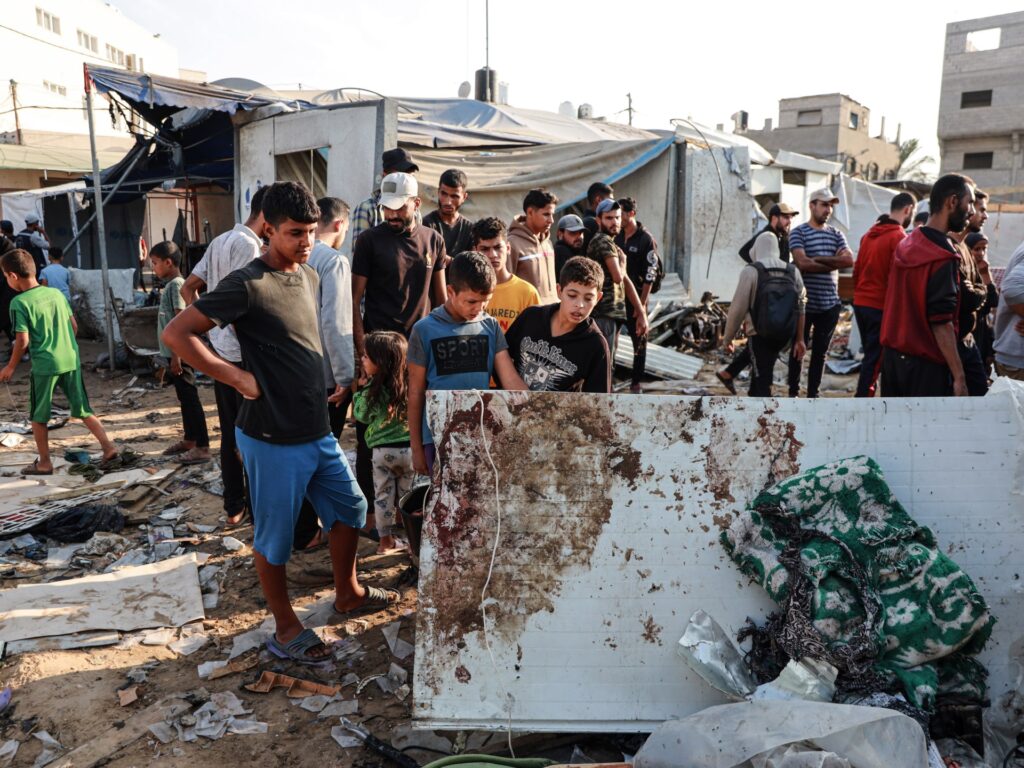Israeli forces have killed dozens of Palestinians across the Gaza Strip in a series of attacks as they have allowed small amounts of aid into the northern part of the enclave. This is the first attack after more than a month of heightened siege.
At least 40 people have been killed since dawn across Gaza on Friday night, including 24 in the north, Palestinian news agency Wafa reported medics saying.
At least six Palestinians were killed on Saturday when the Fahd al-Sabah school, which shelters displaced people, was targeted in the Tufa district, according to the Al Jazeera team in Deir el-Bala.
The dead included two local journalists, a pregnant woman and a child. The Israeli military gave a general justification that it targeted “terrorists” but did not provide evidence or details.
Five more people were killed in Gaza City’s Shujaya district, and at least one person was killed by Israeli sniper fire in Zeitoun district.
At least nine people have been killed in Israeli bombings of tents of displaced people in the so-called “humanitarian zone” of al-Mawasi in the southern Gaza Strip’s Khan Yunis district. According to Nasser Hospital, which accepted the casualties, the dead included one child and two women.
An air raid by Israeli attack helicopters targeted the courtyard of Al-Aqsa Martyrs Hospital, the main medical facility in central Gaza. This was the eighth Israeli attack on the facility since March.
Al Jazeera’s Malam Humaid, who is at the scene, reported that at least three people were killed and 26 injured. The attack took place just 20 meters (65 feet) from the Al Jazeera tent in the area.
On Saturday, the 400th day of the war, the Gaza Health Ministry announced that at least 43,552 Palestinians had been killed and 102,765 wounded.
The actual death toll is estimated to be much higher, with an estimated 10,000 bodies buried under vast rubble of destroyed buildings across the enclave.
The United Nations Human Rights Office denounced the fact that nearly 70 percent of those killed in Gaza were children and women.
More than 1,000 medical workers and at least 12,700 students were killed. About 86,000 tons of explosives were dropped over Gaza, destroying much of the infrastructure and forcing the evacuation of about 2 million people, or about 90% of the population.
The amount of aid granted by Israel is significantly lower than the US target
Israel has allowed limited aid into the area for the first time in more than a month since the Israeli military launched a massive ground offensive into northern Gaza, cutting off aid.
COGAT, the Israeli military agency in charge of aid organizations, said 11 trucks carrying food, water and medical equipment had been brought to distribution centers for those still stranded in Jabalia and Beit Hanoun in the north.
The United Nations’ World Food Program (WFP), which was involved in the delivery process, said not all of the limited aid reached the handover point, and one truck ordered by Israeli soldiers in Jabalia, the main focus of the ground invasion, was unloaded. I reported that I had been dropped off.
For thousands of families in Gaza, humanitarian aid is the only means of survival. It must be increased and maintained.
In October, WFP was able to bring in less than 30% of what it needed due to restrictions.
🎥 WFP’s Noor explains the challenges faced by families. pic.twitter.com/OnLk74pEmm
— World Food Program (@WFP) November 9, 2024
The small-scale grant of aid came with only days left before the deadline the US gave Israel, but it could affect future arms transfers to Israel.
The US government has said Israel must bring in at least 350 trucks a day carrying aid to the Gaza Strip, a far cry from what Israel currently allows and the amount aid groups need in the enclave. That’s significantly less than the up to 700 trucks a day.
In an unprecedented warning, the independent Famine Review Commission said on Friday that famine was likely imminent in parts of northern Gaza and immediate action was needed to alleviate the catastrophic situation.
In response, the Israeli military claimed that researchers from international organizations “continue to rely on partial and biased data and superficial sources with vested interests.”
The director of Kamal Adwan Hospital in the besieged north reiterated the worsening situation, saying the facility was overwhelmed and many injured people were unable to reach the hospital due to a lack of ambulances and targeting of vehicles in the area. It sounded the alarm.
“We have no medicines or medical supplies,” Hassam Abu Safia told Al Jazeera. “We don’t have a surgeon. We only have a pediatrician and a few general internists.”
This comes as the Israeli military continues to block international journalists from entering the Gaza Strip to report on the situation.
At least five journalists were killed in an Israeli airstrike in October, according to the New York-based Committee to Protect Journalists (CPJ), and the Israeli military launched a smear campaign against six Al Jazeera journalists covering the north.
“There are now few professional journalists left in the north to document what multiple international organizations have described as a campaign of ethnic cleansing,” the ministry said in a statement.



